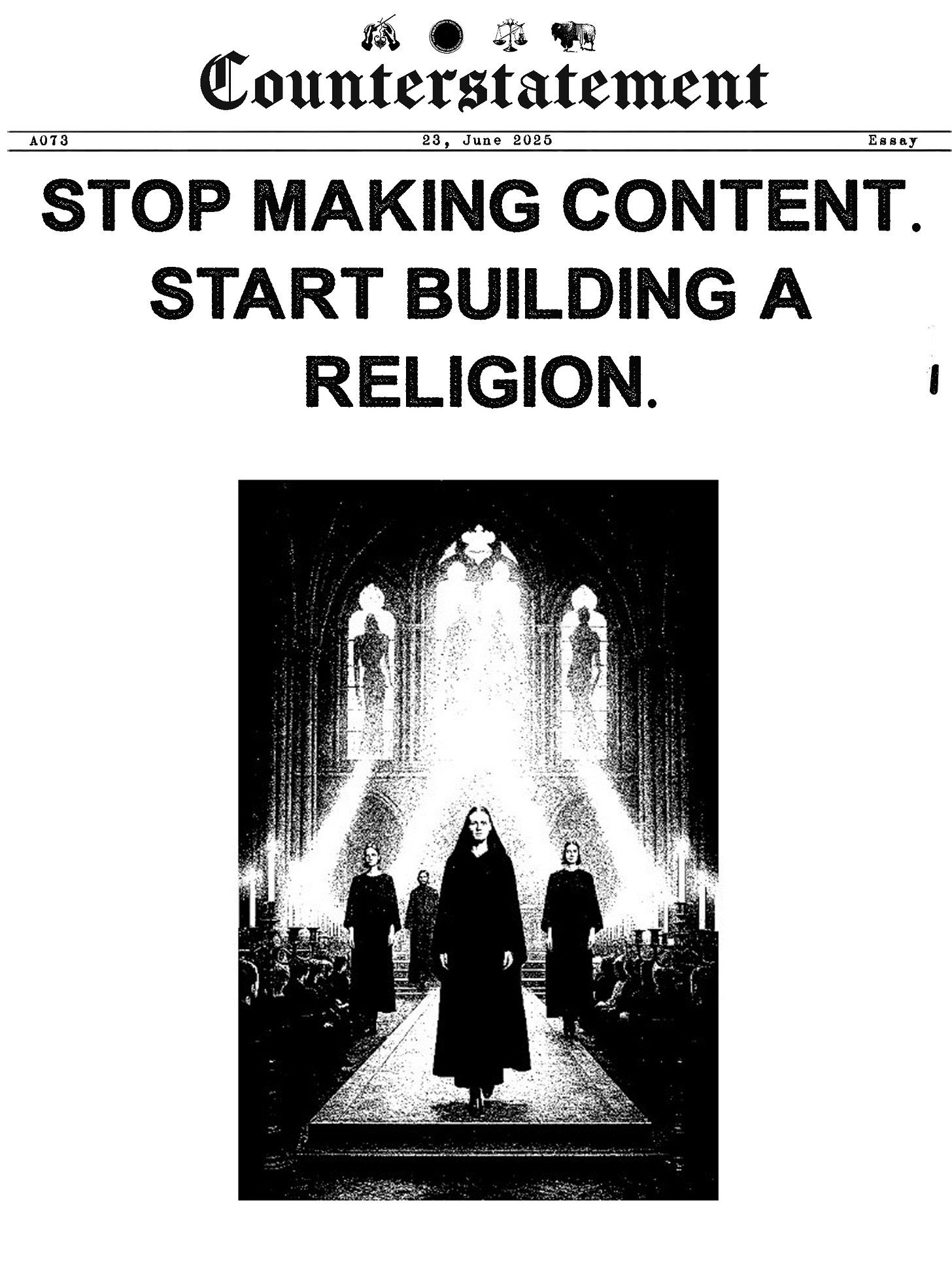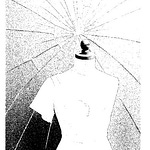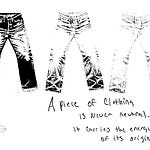1. Internal Philosophy → External Output: Internal Mythos as Creative Engine
The most enduring fashion brands don’t begin with trend reports or consumer data, they begin with an idea of the world. A conviction. A personal mythology. They design not in reaction to culture, but in service of a singular worldview they believe deserves to exist, whether or not the market is ready. Where most brands look outward and ask, “What’s happening now?”, these designers look inward and ask, “What needs to be made real?”
Rick Owens doesn’t design to fit into fashion. He designs to rebuild civilization from scratch. His work draws from brutalist architecture, mythic antiquity, post-apocalyptic sensuality, and the sacred geometry of ruin. Every collection is a chapter in an ongoing mythos, less about seasonal novelty, more about spiritual continuity. Owens isn't making clothes. He’s building a universe governed by its own laws.
Comme des Garçons, under Rei Kawakubo, operates with a similarly radical independence. Each collection is constructed around an abstract idea, often rooted in fragmentation, asymmetry, deformation, or negation. She uses the runway not as a marketing tool, but as a philosophical battlefield. The brand’s work questions beauty, functionality, gender, and the very purpose of fashion itself. Rei doesn’t design for approval, she designs to dismantle expectations.
The common thread?
These brands do not mirror the world, they project a new one.
They do not wait to be inspired by culture, they generate their own cultural logic.
Mechanism:
They build from the inside out.
The philosophy comes first. The form follows.
The brand is not reacting to the world, it is offering an alternative to it.
2. Continuity Over Novelty, The Continuum Principle
Where most brands chase the illusion of “what’s next,” Rick Owens and Rei Kawakubo commit to what’s deeper. They understand that true innovation isn’t about constant reinvention, it’s about disciplined evolution. Their work doesn’t rely on surprise, gimmick, or seasonal reinvention. Instead, it unfolds like a slow, deliberate incantation.
Rick Owens builds with the patience of an architect and the obsession of a mythmaker. His silhouettes don’t change to catch attention, they mutate over time, absorbing new influences without ever losing the integrity of the world he’s constructing. A Rick Owens coat from ten years ago still speaks the same language as one from today, only now, the dialect is more refined, more ancient, more precise. His work accumulates meaning, becoming denser with every collection. It’s not a trend cycle, it’s a deepening spiral.
Comme des Garçons, led by Rei Kawakubo, takes a more chaotic path, but one that is equally anchored in internal continuity. Each collection exists as a stand-alone concept, sometimes visually or thematically contradictory to the last, but always grounded in Rei’s lifelong commitment to dismantling assumptions. One season might focus on volume and emptiness, the next on constraint and deformity. But it is never mimicry. It is never a response. It is always exploration within the boundaries of her own philosophy.
Their work feels less like a timeline and more like a body of literature, each chapter a new voice, but the same author. The audience doesn’t just follow the collections. They study them. Revisit them. Search them for signs, symbols, and evolution.
Mechanism:
They resist the shallow demands of novelty and instead pursue the long arc of authorship.
There is a throughline, sometimes linear, sometimes fragmented, but always unmistakably their own.
They are not building trends.
They are building mythologies, coherent, enduring, and alive.
3. Rejection of Market-Led Feedback
Some brands listen too closely to the crowd, and lose themselves in the process. But the most enduring cult labels aren’t built on data dashboards or viral algorithms. They’re built on conviction.
Designers like Rick Owens and Rei Kawakubo don’t pander. They don’t poll. They don’t post to appease the algorithmic gods of engagement. Their creative decisions aren’t reactions, they’re declarations. If the audience doesn’t immediately “get it,” that’s not a flaw, that’s the point.
In a cultural landscape obsessed with likes, shares, and comment-section approval, their refusal to explain or adapt becomes an act of radical authorship. They resist the slow erosion of identity that happens when a brand adjusts itself to meet every expectation. Instead, they maintain strategic illegibility, a kind of cultivated difficulty that filters the curious from the conformist.
They don’t dilute. They don’t translate. They preserve the purity of the vision, even if that means alienating those who weren’t meant to belong in the first place.
Mechanism: Silence as strategy. Vision over virality.
Their work doesn’t chase the market, it dares the market to catch up.
4. Design as Ideology, Not Just Product
For cult-defining designers like Rei Kawakubo and Rick Owens, fashion isn’t merchandise, it’s philosophy made material. Their garments don’t merely clothe the body, they confront it, question it, and reimagine its possibilities. Every seam, silhouette, and staging decision is a deliberate expression of worldview.
Rei doesn’t just design clothing, she deconstructs assumptions. Her garments distort the human form, not for shock value, but to challenge deeply embedded cultural ideals about beauty, gender, symmetry, and identity. Her work is confrontation through fabric.
Rick Owens, on the other hand, builds myth. His shows feel more like rituals than presentations, funerals for the status quo, baptisms into an aesthetic philosophy of strength, decay, and sensual apocalypse. The clothes aren’t designed to be trendy. They’re designed to speak, to unsettle, to command loyalty from those who see themselves reflected in their raw, sculptural drama.
These aren’t seasonal collections, they’re ongoing ideological statements. The garments exist as artifacts of belief, challenging the audience to either enter the world they propose or remain outside it.
Mechanism: The runway becomes a pulpit. The collection, a sermon.
Every drop is not a product release, it’s a cultural intervention.
In a world addicted to novelty, the most enduring designers don’t chase relevance, they generate reality. Their work isn’t reactive, it’s revelatory. Because in the end, a true brand isn’t built on content, trends, or metrics, it’s built on belief. And belief, once made visible, doesn’t fade. It echoes.













